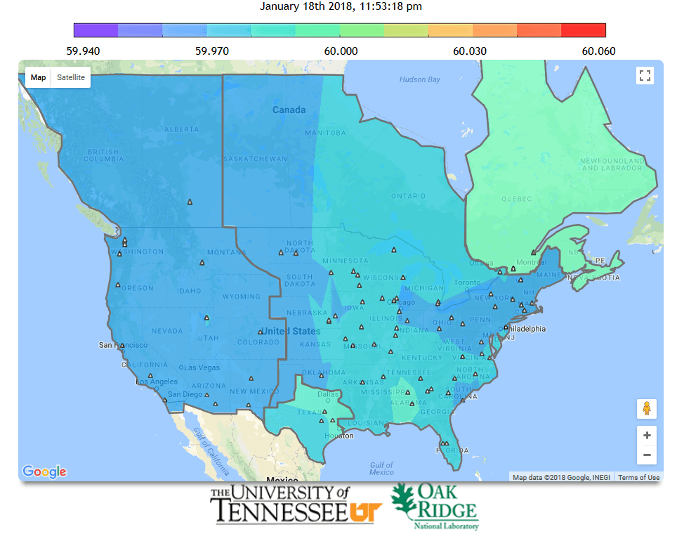Synchrophasors are time-synchronized numbers that represent both the magnitude and phase angle of the sine waves found in electricity, and are time-synchronized for accuracy. They are measured by high-speed monitors called Phasor Measurement Units (PMUs) that are 100 times faster than SCADA. PMU measurements record grid conditions with great accuracy and offer insight into grid stability or stress. Synchrophasor technology is used for real-time operations and off-line engineering analyses to improve grid reliability and efficiency and lower operating costs.
American Recovery and Reinvestment Act Synchrophasor Projects
Recovery Act Smart Grid Investments have supported the installation of over 1,000 PMUs across North America, supported with high speed communications networks, and advanced analytical applications to use the data. Twelve Smart Grid Investment Grant (SGIG) projects and two Smart Grid Demonstration Projects have installed PMUs at a total project cost of over $328 million (combined federal and private funding).
See project status information (PDF):
See project locations and information >>
Program Documents
- Factors Affecting PMU Installation Costs - October 2014 (PDF)
- Use of IEC 61850-90-5 to Transmit Synchrophasor Information According to IEEE 73.118: NASPI Tutorial, October 16, 2012 - August 2014 Update (PDF)
- Phasor Tools Visualization: NASPI Technical Workshop - June 2014 (PDF)
- Synchrophasor Technology and Renewables Integration: NASPI Technical Workshop - June 2014 (PDF)
- Model Validation Using Synchrophasors NASPI Technical Workshop - October 2013 (PDF)
- Sychrophasor Technologies and their Deployment in the Recovery Act Smart Grid Programs – August 2013 (PDF)
Recipient Documents
- Use Synchrophasor Data to Accelerate Reclosing of an Important Tie Line - March 2014
- Synchrophasor Data used to Calibrate and Validate Columbia Generating Station (CGS) Model - August 2012
- Entergy Phasor Project Documentary – January 2012
The North American SynchroPhasor Initiative
The North American SynchroPhasor Initiative (NASPI) is a collaborative effort between the U.S. Department of Energy (DOE), the electric power industry, and academia. NASPI was established in 2007 to advance the understanding and use of synchrophasor technology, and is a forum for Recovery Act Smart Grid Investment recipients to share information and lessons learned, solve problems, develop technical standards, and further the development of synchrophasor technology. As a result, much of the collective insights and work products produced by NASPI are direct outcomes of the Recovery Act Smart Grid Investments. DOE has funded NASPI research and national laboratory participation in NASPI since 2007, and began supporting NASPI directly at the start of 2014.
View these related publications:
Map of Synchronized Sensors on the U.S. Grid
System frequency is one of the electric grid's "vital signs" much the same as a human's pulse or temperature. The University of Tennessee in Knoxville, in collaboration with Oak Ridge National Laboratory, deployed a system of global positioning system (GPS) synchronized sensors to measure the voltage angle and frequency of the electric grid on a wide-area basis. The map shows the frequency of each of the North American interconnections in real time. This is the broadest wide-area electric grid sensor network in the world — allowing power system engineers to see the dynamic behavior of the total interconnected electric grid and to understand how the various geographical regions interact with one another. These data flow from the remote sensors into the central processing facility in Knoxville, where it is time-synchronized and incorporated into the map. This data is used by experts across North America when they investigate electricity blackouts.

Additional Resources
- Synchro-Phasor Data Conditioning and Validation Report Phase 1, Task 2 Report - August 2013 (PDF)
- Standard MOD-026-1: Verification of Models and Data for Generator Excitation Control System or Plant Volt/Var Control Functions - April 2014 (PDF)
- Standard MOD-027-1: Verification of Models and Data for Turbine/Governor and Load Control or Active Power/Frequency Control Functions - April 2014 (PDF)
- Standard PRC-002-NPCC-01: Disturbance Monitoring - April 2014 (PDF)
- Real-Time Application of Synchrophasors for Improving Reliability - October 2010 (PDF)
Projects
The location, information, and data for each smart grid project are provided in this section.Click for Projects
Publications
These reports include analysis, impacts, lessons learned, best practices, analytical tools, and case studies that were supported by the Recovery Act Smart Grid Programs.Click for Publications

